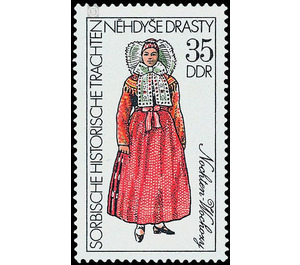Sorbian historical costumes - Germany / German Democratic Republic 1977 - 35 Pfennig
Theme: Art & Culture
| Country | Germany / German Democratic Republic |
| Issue Date | 1977 |
| Face Value | 35.00 |
| Color | multi-colored |
| Perforation | K 14 1/4 |
| Printing Type | Rotogravure 2 |
| Stamp Type | Postage stamp |
| Item Type | Stamp |
| Chronological Issue Number | 1955 |
| Chronological Chapter | GER-DDR |
| SID | 775004 |
| In 24 Wishlists | |
Sorbian Historical Costumes The Ministry of Posts and Telecommunications of the German Democratic Republic issues five multicolored special postage stamps with pictures of Sorbian historical women's costumes. Sorbian historical costumes Around the middle of the 19th century, all Sorbian girls and women of Lusatia wore folk costumes, while the men were already turning to fashionable clothing. Today, Sorbian folk costumes can only be found in four costal regions in the districts of Cottbus and Dresden, where they usually carry only older women. As early as 1968 festival costumes and 1972 dance costumes were displayed on special postage stamps from these areas. The present series is dedicated to the Sorbian-historical costumes, which, on a recent occasion in honor of the IX. Federal Congress of Domowina, the socialist national organization of the Sorbs, appears. These costumes, also known as truids, were created in the past for a variety of reasons. They have completely disappeared from the public today, and can only be found in chests or museums. Like the costumes that still live, they too bear witness to the wealth of ideas and creative power of the working people. 35 pfennig value: Costume from Nochten In only three villages of the Parish Nochten in the district of Weißwasser, which are today in the immediate vicinity of the power plant Boxberg, this charming costume was worn, from the costumes and dancing costume of the girls is shown around 1890. Located in the middle of the large forest area of the Muskauer Heide, not even the flax needed for domestic linen production thrived on the barren sandy soils. This is why cheap industrial fabrics such as calico and simple woolen fabrics were used to make the costume very early on. All costumes have a strong coloration, and despite the small size of the traditional costumes a variety of functional differentiations existed. Enriched and decorated in folk art were also here, especially parts of the festive costumes by cross and hole embroidery.


